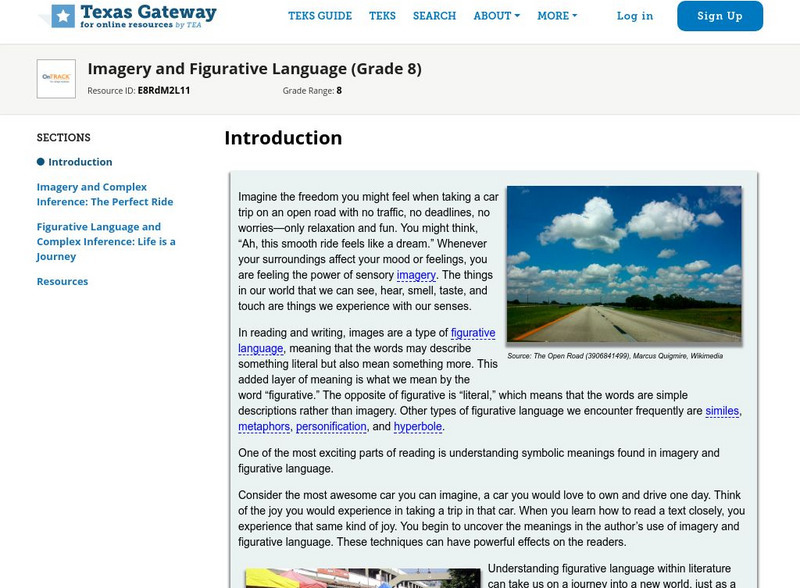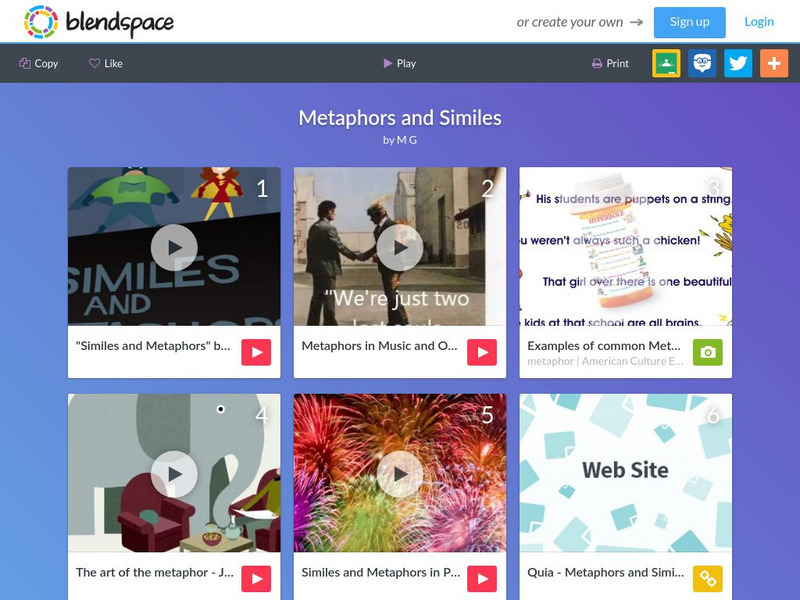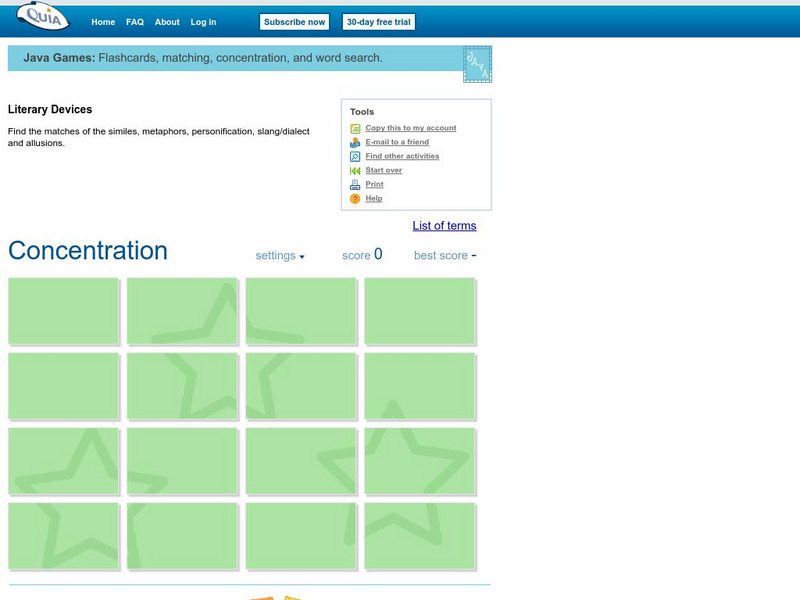Hi, what do you want to do?
Alabama Learning Exchange
Alex: Figurative Language
This lesson used a slideshow presentation to explain the difference between similes and metaphors. Students are challenged to identify these figurative elements in literature and then create some themselves.
Texas Education Agency
Texas Gateway: Imagery, Metaphor, and Simile (English Ii Reading)
This lesson focuses on understanding imagery, metaphors, and similes.
Texas Education Agency
Texas Gateway: Imagery and Figurative Language (Grade 8)
In this lesson, students learn how to make complex inferences and use textual evidence such as imagery and figurative language to support understanding.
TED Talks
Ted: Ted Ed: The Art of the Metaphor
How do metaphors help us better understand the world? What makes a good metaphor? Explore these questions in this video with writers like Langston Hughes and Carl Sandburg, who have mastered the art of bringing a scene or emotion to...
Alabama Learning Exchange
Alex: Poetry and Music Fun With Chris Daughtry
This language arts lesson grabs students' attention by incorporating a popular musician. The lyrics to "Over You" include vivid language that makes identifying figures of speech intriguing. The students will identify similes, metaphors,...
Writing Fix
Writing Fix: How to Make Poetry
Students learn how to write poetry through ten Writing Workshop mini-lessons. Students complete the graphic organizers provided while learning to notice details, write similes and metaphors, and create patterns in their writing.
Read Works
Read Works: 3rd Grade Lesson: Poetry
[Free Registration/Login Required] A lesson in which students use two provided poems to learn to identify and understand the use of similes and metaphors in poetry. Lesson includes direct teaching, guided practice, and independent...
ReadWriteThink
Read Write Think: Figurative Language Awards Ceremony
Contains plans for five to seven lessons that teach about figurative language like similes, metaphors, and personification by asking students to write award acceptance speeches that incorporate them. In addition to objectives and...
E Reading Worksheets
E Reading Worksheets: Figurative Language Worksheets
This learning module provides remediation and extra practice with identifying different types of figurative language. Reinforcement is provided through the worksheets, quizzes, video game links, and online sites for the following types...
TES Global
Blendspace: Figurative Language & Tone
A twelve-part learning module with links to texts, videos, and websites on figurative language and tone.
Love To Know Media
Your Dictionary: Literary Terms Lesson Plan
This is a lesson plan for teaching the seven literary terms used in poetry: simile, metaphor, alliteration, imagery, hyperbole, personification, and onomatopoeia.
Annenberg Foundation
Annenberg Learner: Journey North: Reading Strategies: Compare and Contrast Ideas
This reading resource discusses the strategy of comparing and contrasting ideas. Students will learn definitions and explanations for similes, metaphors, and analogies. A list of guiding questions is provided to help students as they...
ClassFlow
Class Flow: Metaphors and Similes
[Free Registration/Login Required] This flipchart introduces metaphors and similes. It also provides practice and a writing assessment.
Houghton Mifflin Harcourt
Houghton Mifflin: Teacher's Guide to "The Polar Express" [Pdf]
This teachers' guide for "The Polar Express" by Chris Van Allsburg has lessons designed for both early elementary and intermediate students. It includes working with a timeline and learning about similes and metaphors. (In PDF format.)
TES Global
Blendspace: Metaphors and Similes
A twelve-part learning module with links to videos, images, websites, and a quiz on metaphors and similes.
ClassFlow
Class Flow: Metaphor & Simile
[Free Registration/Login Required] This flipchart helps students understand the use of metaphors and similes in written and spoken language. There are several fun examples, activities and whole group feedback using Activotes.
E Reading Worksheets
E Reading Worksheets: Figurative Language Examples
Along with definitions for four types of figurative language, this learning module provides numerous examples. Similes, metaphors, personification, and hyperbole are the types of figurative language featured.
E Reading Worksheets
E Reading Worksheets: Figurative Language: Reading Test 3
A ten-question quiz on recognizing similes, metaphors, hyperbole, and personification. Results can be printed, saved, or emailed.
Quia
Quia: Concentration: Literary Devices
This game asks students to match literary devices (similes, metaphors, personification, slang/dialect and allusions) with their examples while remembering where they are located behind covered squares. Java is required.
ClassFlow
Class Flow: Figurative Language
[Free Registration/Login Required] This resource explores figurative language including similes, metaphors, and personification. There are many activities used to support the exploration of each type of figurative language.
CK-12 Foundation
Ck 12: 6.1 Writing About Literature: Analyzing Prose
[Free Registration/Login may be required to access all resource tools.] Learn to analyze prose by understanding connotation and denotation, identifying metaphors and similes, looking for repetition, and finding imagery in a text.
Other popular searches
- Metaphors and Similes
- Poetry Similes and Metaphors
- Metaphors and Similes Test
- Using Similes and Metaphors
- Autumn Metaphors and Similes
- Similes and Metaphors Poem
- Poems Similes and Metaphors
- Lyrics Metaphors and Similes
- Writing Similes and Metaphors






















